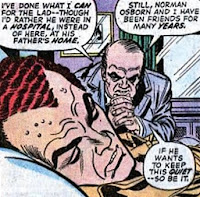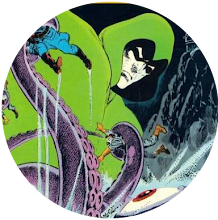I must declare that the issue of Marvel UK's Super Spider-Man that reprinted The Amazing Spider-Man #121 failed to be stocked by my local newsagent.
Was he trying to spare his readership the soul-shattering horror of it all? Or was it just the delivery van having broken down?
Perhaps we shall never know but it does mean I only joined the two-parter for its second half, reprinted from The Amazing Spider-Man #122.
Fortunately, the world sometimes being a wonderful place, years later I finally got to read the first part of the tale.
So, with The Amazing Spider-Man hitting our cinema screens even as I speak and the internet abuzz with talk of Emma Stone's Gwen Stacy, it's time to do the decent thing and gawp at her death.
 I do of course mean Gwen Stacy's death, not Emma Stone's. Emma Stone is alive and well and will no doubt be back to play both Gwen Stacy and Mary Jane Watson in future instalments.
I do of course mean Gwen Stacy's death, not Emma Stone's. Emma Stone is alive and well and will no doubt be back to play both Gwen Stacy and Mary Jane Watson in future instalments.Gwen Stacy's death happens in Amazing Spider-Man #121 and it all kicks off with Norman Osborn fretting over the illness of his son Harry who's back on the drugs. Not only that but Norman's business is threatening to fail and he has a doctor who looks exactly like Bullit from Amazing Spider-Man #91.
Faced with such dilemmas, Osborn reacts as anyone normal would. He dresses up as a goblin and flies around on a metal bat, out to kill his son's best friend.
Arriving at Peter Parker's apartment, he finds not Spider-Man but Gwen Stacy and kidnaps her, setting up a confrontation with our hero on a George Washington bridge that looks remarkably like the Hudson Bridge.
 In the ensuing fight, the Goblin knocks Gwen from the top of the bridge and, despite Spider-Man thinking he's saved her from guaranteed death, it turns out he hasn't.
In the ensuing fight, the Goblin knocks Gwen from the top of the bridge and, despite Spider-Man thinking he's saved her from guaranteed death, it turns out he hasn't.Its certainly not a tale short of incident. Nor is it short of intensity, as we get the drama of Harry's drug relapse followed by Osborn's breakdown before topping it all with the shocking climax. Gil Kane's story-telling's as masterful as ever and Jazzy John Romita's inks help maintain the look the strip's had since Steve Ditko left way back in issue #38. We even have time for a little J Jonah Jameson amidst it all.
But, whatever else goes on in the tale, the talking point's inevitably its climax.
And it's here the tale's at its best and at its most frustrating. It's impossible to ignore the power and shock value of it all as Spider-Man thinks he's triumphantly saved Gwen, only to realise he's done nothing of the sort.
On the downside, it does get bizarrely ambiguous about how exactly she's died, suggesting no clear consensus between, writer, editor, letterer and artists as to how it's actually happened.
Gil Kane and John Romita's depiction of Gwen lying totally motionless throughout the fight suggests they may have intended her to be dead all along, killed by the Goblin before Spidey even reached the scene.
 |
| Emma Stone as Gwen Stacy - alive and well. For now... |
Then again, just one page later, writer Gerry Conway has the Goblin bafflingly declare, “Romantic idiot! She was dead before your webbing reached her! A fall from that height would kill anyone before they struck the ground!”
Leaving aside the fact that a fall from that height clearly wouldn't kill someone before they hit the ground, the declaration leaves the waters disappointingly muddy.
Personally I take the view that Gwen should've been revealed to have been dead all along; with the, “snap,” and the Goblin's bizarre claim being left out. I suspect though that others may disagree.
Whatever the truth of it, the death of Gwen Stacy sent a shock-wave through the world of comics and may have signalled the end of the Silver Age and the start of a grimmer Bronze Age.
In all honesty, despite this issue's many merits, I do prefer the second part of the tale - for its sheer intensity and Peter Parker's seething anger - but issue #121's certainly a more-than-capable set-up for that classic issue.












































































13 comments:
Yes, it was a truly terrible day, wasn't it. And nearly forty years later, and we're no closer to the truth than what we were in '73. Bizarre machinations were running deep in the Osborn-Stacy world in those days. Marvel's revisionism has clouded reality to the point where we're in need of a Zapruder film to help us get back to the grim truth.
It was once believed (and may still be) that the shock alone would kill someone falling from a great height before they hit the ground. Perhaps that's what the Goblin meant. However, if it was Spidey's web jerking her to a stop that broke her neck, then Peter is responsible for killing her in the act of saving her - how ironic. You'd think the writers would have played up Peter's guilt over that in subsequent years - they clearly missed an opportunity.
Kid and RW, thanks to you both for your comments.
A, "How did Gwen Stacy die?" poll has now been added to the sidebar.
Did I imagine, or dream, that the 'snap' was only added to later reprints?
I've always thought it was in the original but then removed in reprints. Then again, I could be remembering it wrong.
Or possibly that it wasn't included in the UK SM where I read it first?
Ah, mystery solved - not included in some reprints: http://en.wikipedia.org/wiki/The_Night_Gwen_Stacy_Died
I was never in to comics much as a kid but my parents bought me a Spiderman album as a Christmas present in about 1983 when I would have been 9 yo, that had The Night Gwen Stacey Died reproduced in it. At the time I didn't understand the more adult themes in it such as schizophrenia and drug abuse but the story made a big impression on me. Pity I didn't keep the album! :(
I remember being shocked by this and I agree that some of the later revisionism is truly tasteless. I never agree with those like Gerry Conway who thought that Gwen as a character had outlived her usefulness because she was too nice. she had her spiky side just like MJ did but in different ways. I think Marvel ought to remember more that Gwen was Peter's real love and that to an extent MJ is always no. 2. Mind you, they seem to have got fed up with MJ now as well.
I've always had the grim perception that Gwen was unconscious when the Goblin knocked her off the bridge and she died during the fall.
Whether a great fall could kill you if you were knocked out and not aware of it, I couldn't tell you.
But this what the comic book clearly seemed to be saying in the end.
Oh, and apparently Stan HATED the death of Gwen.
Everywhere he spoke, some heart-broken fan would ask him why he killed Gwen Stacy.
I think if he had been in the office that day, it wouldn't have happened.
Oh, and I'll always maintain that 'The Dark Knight Returns' ushered in the Bronze Age of comics.
The SNAP! is apparent in both my copy of No 121 and the 1986 reprint in Marvel Tales. The only difference is that it's been colourised orange-yellow in the reprint for whatever reason.
The Bronze Age began in the early '70s with Marvel and DC moving into darker territory on so many different levels--often defying the censorious Comics Code. It was also marked by the replacement of key writers like Stan Lee with Gerry Conway, and the 'demoting' of major artists like Jack Kirby.
The Dark Knight Returns helped usher in the Pearl Age of comics. You can read all about that in the lead-off article from the latest edition of my Comics Decoder site (shameless plug!).
The Pearl Age! That is getting desperate.
Post a Comment